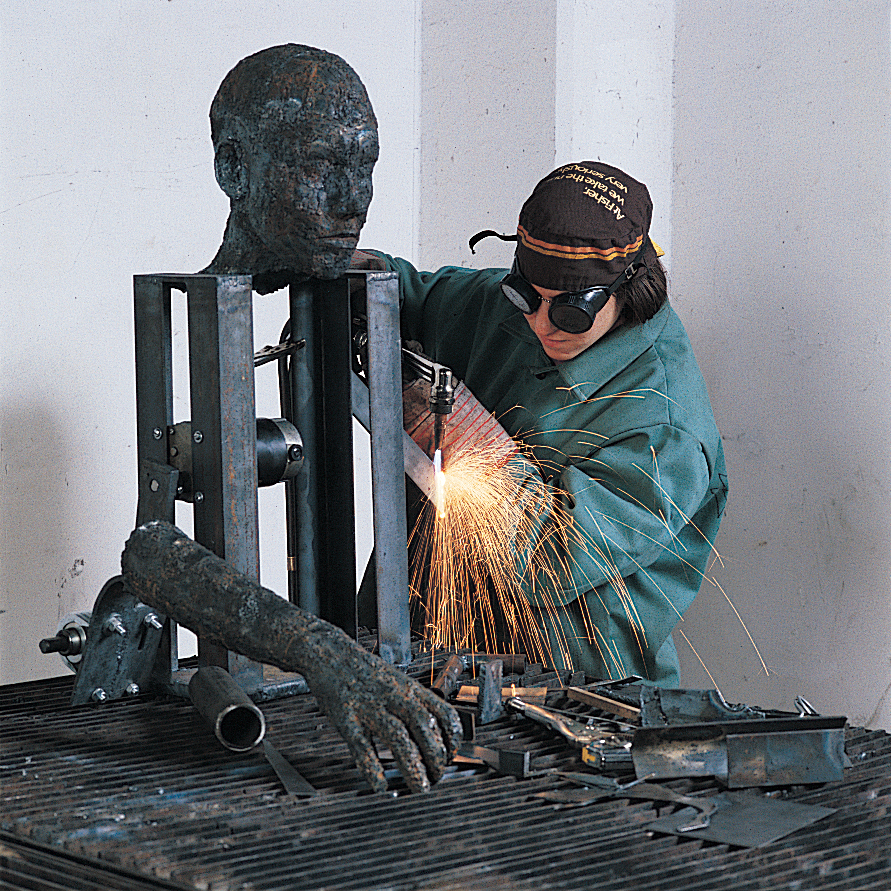Welding is a method of permanently joining two pieces of material using heat or pressure. It is one of the most important ways of joining metals. Manufacturers weld together metal parts to make many products. These products include automobiles, bicycle frames, and furniture. Construction firms use welding to make bridges, buildings, and ships.

There are more than 60 different welding processes. They fall into two broad categories, fusion welding and solid-state bonding.
Fusion welding
Fusion welding uses heat to melt specific areas of metal parts to be fused (joined). The heat often comes from an electric current. But it also may come from a flame or a powerful laser.
The melted metal areas then cool and solidify. The resulting joint can be as strong as the rest of the metal. Most fusion welding processes also use a filler metal to fill any gaps between the joined parts. Heat from the welding process melts the filler metal along with areas of the metal parts. The molten weld cools quickly, fusing the pieces of metal together.
In most fusion welding, the welded area must be shielded from oxygen and hydrogen in the air. If metals absorb these gases, the weld becomes weak or brittle. Some welding processes cover the welded region in a protective blanket of inactive gas. Such gases include argon, carbon dioxide, and helium. Other processes apply a nonmetallic flux to the filler metals before welding. The flux melts and covers the metals, protecting them from the air.
Arc welding
is a common type of fusion welding that generates heat from an electric spark. A power supply connects to the metal parts and a device called an electrode. The electrode is typically part of a handheld structure called a welding torch or gun. When the electrode is brought close to the metal parts, a continuous electric spark jumps between them. This spark, called an arc, completes the electric circuit. The spark reaches temperatures greater than 6000 °F (3300 °C).
Welders move the electrode across the parts to be joined, producing a length of melted weld. They use special dark welding goggles or shields to protect their eyes from the arc’s bright light. There are a number of specific methods for arc welding. They include shielded metal arc welding, gas metal arc welding, and gas tungsten arc welding.
Shielded metal arc welding
is also called stick welding. It is the most widely used welding process. It uses an electrode covered with a layer of flux. The electric arc melts areas of the metals along with the flux and the electrode itself. All of these materials become part of the weld. As the flux melts, it shields the melting metal parts from the air. It also causes impurities in the weld metal to float to the surface. The result is a layer of slag. After the slag cools, it is chipped away with a hammer.
Shielded metal arc welding is used only for welding iron and steel. It takes great skill. But it can be used in many locations and in awkward positions unsuitable for other welding methods.
Gas metal arc welding
uses an inert gas for shielding, instead of flux. It is also called metal inert gas (MIG) welding or wire welding. Like shielded metal arc welding, it uses an electrode that melts from the heat of the arc, along with the metal parts to be joined. A wire of filler metal is fed through the welding torch from a spool. Robots often perform gas metal arc welding for a wide variety of metals.
Gas tungsten arc welding
uses a shielding gas and an electrode made of tungsten. The tungsten does not melt in the arc’s heat. The welder must use a separate rod of filler metal to fill any gaps between the welded parts. This process can produce fine, easily controlled welds in all metals. A closely related process is called plasma arc welding. It produces much hotter temperatures in the weld zone than standard welding methods.
Other fusion welding methods
do not produce an electric arc. They include gas welding, laser welding, and resistance welding.
Gas welding
uses heat from a gas flame to join metals. The most common welding gas is acetylene. It is mixed with oxygen and ignited (see Acetylene ). A separate filler metal can be added to the weld to fill gaps. Gas welding is commonly used for repairs.
Laser welding
uses a high-powered laser to create a weld between closely fitted metal plates. This method can easily weld thick plates. But the high cost of lasers limits its use.
Resistance welding
joins metals by passing an electric current through the metal parts. The current heats up their internal structures. Automobile assembly lines use resistance welding to join thin sheet metal parts.
Solid-state bonding
Solid-state bonding uses high pressure to join metal parts together. The name comes from the fact that the materials stay solid, instead of melting together.
One type of solid-state bonding is called deformation bonding. In it, high pressure squeezes two pieces against each other so strongly that their individual atoms bond together. The nickel and copper layers of United States quarters are bonded together in this way. Diffusion bonding resembles deformation bonding. But it uses lower pressures over a long period of heating to create a bond.
